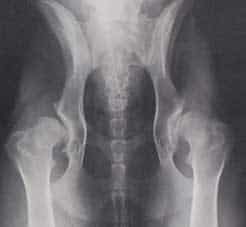What is Canine Arthritis?
by Dr. Robert Brady
What Is It?
Arthritis is a joint problem that can reduce mobility and cause pain. Often seen in older dogs, arthritis can be caused by injury, infection, the body’s own immune system, or developmental problems. The most common form of arthritis is called osteoarthritis (osteo = bone; arthr = joint; itis = inflammation) or degenerative joint disease. Normally, joints form smooth connections between bones. Osteoarthritis involves thinning of joint cartilage (a protective cushioning between bones), buildup of fluid within the joint, and the formation of bony growths within the joint. Over time, this can lead to reduced joint mobility as well as pain.
- Osteoarthritis affects one of every five dogs.
- Thinning of joint cartilage can lead to a vicious cycle of joint deterioration, reduced mobility, and pain.
- Supportive care is important, and treatment may include pain medication, NSAIDs, corticosteroids,supplements, massage, therapeutic laser, warm compresses, and/or surgery.
- Regular, moderate exercise may help delay canine arthritis.
Signs and Diagnosis
- Stiffness after exercise or rest
- Wasting away of muscle
- Limited movement
- Joint swelling
- Trouble getting up, laying down, walking, climbing stairs, or jumping
- A grating sound in a joint
Recognizing arthritis in dogs can be difficult because the condition progresses slowly and dogs don’t complain about their aching joints. Also, some owners assume that signs of arthritis are “normal” in older animals.
Bringing your dog in for an annual checkup can help your veterinarian identify clinical signs early. Radiography (x-rays) can reveal bony growths and joint abnormalities.
Treatment
- Getting or keeping your dog slim can help by decreasing the load on his or her joints.
- Feeding your dog the right amount of high-quality food should help with weight control.
- Carefully monitored exercise on soft surfaces can help affected dogs..
- Because arthritis is aggravated by cold and damp, keep your dog warm and dry. Padded dog beds can help.
- Warm compresses can soothe affected joints.
- Massage and passive range of motion can increase your dog’s flexibility, circulation, and sense of well-being. Professional animal massage therapists are available.
- Pain medication, including nonsteroidal antiinflammatory drugs (commonly called NSAIDs), may help relieve signs, but you should never give your dog a drug without your veterinarian’s recommendation. Ibuprofen (Advil), Aspirin, and acetaminophen (Tylenol) can be toxic to dogs and cats so never give these medications to your pets.
- Corticosteroids can be used to suppress inflammation, but they are usually used for short periods.
- Glucosamine and chondroitin have been used to help manage arthritis in dogs and other animals.
- Acupuncture isn’t just for people. It’s painless and has shown some success in animals.
- Therapeutic Laser therapy has also been proven to reduce inflammation and pain associated with arthritis in dogs.
- Surgery may be a good choice in advanced cases of canine arthritis including total hip replacements.
- A low-stress environment, plenty of affection, and supportive care can help improve your dog’s quality of life.
Prevention
Regular, moderate exercise and a high-quality diet can help delay aging, keeping your pet thin, and early intervention when a problem is suspected all help delay the progression of arthritis.
Aids for Arthritic Dogs
- Slip-free flooring/ grip enhancement for your pets feet
- Soft bedding
- Ramps (instead of steps)
- A warm, dry environment
- Assisted grooming
- Regular veterinary visits
- Pain medications when warranted
- Rehabilitation and Therapeutic Laser treatments


